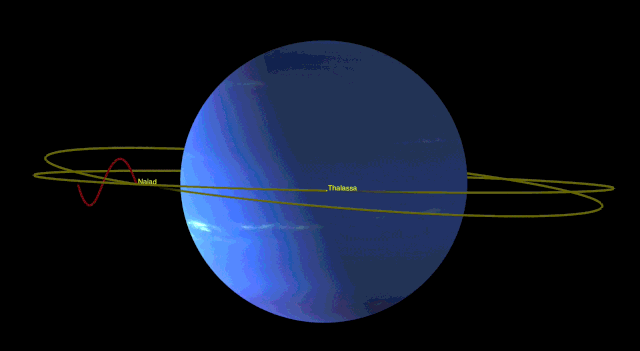16.11.2019
Neptune's two innermost moons are locked in an unusual "dance of avoidance," with their perfect choreography ensuring the moons never get too close to each other.
That's a tricky feat, since their orbital paths are separated by just 1,150 miles (1,850 kilometers). But the moons themselves never come closer than within 2,200 miles (3,450 kilometers) — a few hundred miles shorter than the width of the U.S.
If an observer looks at the moons' orbits edge-on, they would see the moon Naiad dip above and below its neighbor Thalassa because of its slightly tilted orbit. In addition, their dances align so that for every 69 orbits of Thalassa, Naiad orbits 73 times. Then, their choreography begins again from the beginning.
Related: Photos of Neptune, The Mysterious Blue Planet
"We refer to this repeating pattern as a resonance," lead author Marina Brozovic, a solar system dynamicist at NASA's Jet Propulsion Laboratory in California, said in a statement. "There are many different types of 'dances' that planets, moons and asteroids can follow, but this one has never been seen before."

An animation shows the paths of Naiad and Thalassa around Neptune.
Resonances are common among moons of the giant planets, but typically, these relationships are simpler than the one between Thalassa and Naiad. Jupiter, Saturn, Uranus and Neptune collectively have dozens of these worlds to interact. Some of these moons formed with the planets, while some are former asteroids captured by the immense gravity of these planets.
Neptune has 14 confirmed moons. Naiad and Thalassa are both on the small side, each only 60 miles (100 km) long. Studies suggest that Neptune's moon system had a big change when it captured the giant moon Triton, which caused a lot of chaos (and debris from moon collisions) that eventually coalesced into newer moons and rings.
"We suspect that Naiad was kicked into its tilted orbit by an earlier interaction with one of Neptune's other inner moons," Brozovic said. "Only later, after its orbital tilt was established, could Naiad settle into this unusual resonance with Thalassa."
Astronomers studied the dance using the Hubble Space Telescope. The moons' motions are not only interesting to look at, but also provide information about the interior composition of Neptune's inner moons, the team said. Their orbital motions let astronomers compute the mass of these moons, which appear to have densities close to that of water ice.
Quelle: SC
